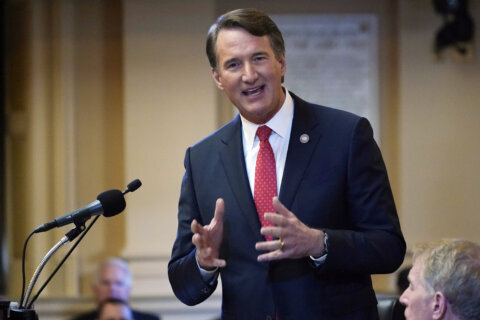This article was reprinted with permission from Virginia Mercury.
When something is not working, change it.
The Virginia Board of Education is proposing that kind of transformative change for its new accountability framework, by splitting up the state’s accreditation system into two parts: an accreditation system, to assess whether schools are meeting all requirements laid out in state laws and regulations; and an accountability system, to provide “timely and transparent information on student and school performance.”
This is another means for Gov. Glenn Youngkin’s administration to completely overhaul the system, which is vague in defining how it constitutes student achievement. Some education advocates support it, saying the changes could raise the state’s standards and improve transparency.
Others fear the revisions could have long-term negative effects on low-performing schools.
Mashea Ashton, one of the most recent board members appointed by the governor, said building the framework takes effort but gives the board another tool to determine how to direct state resources and be more transparent.
“Raising expectations alone is not the one thing that’s going to make this work,” said Ashton last week, “and as I said to the board yesterday, I’ll say again, today, we have to do hard things better.”
Over the next few weeks, the Virginia Board of Education will hold a listening tour to allow school faculty members and parents to talk about the proposed changes. The board hosted another listening tour last year. Public comment will end on April 19.
Last June, Virginia Secretary of Education Aimee Guidera and Superintendent of Public Instruction Lisa Coons provided a report to the General Assembly stating that most states have both an accreditation system and an accountability system.
This, and the governor’s criticisms about students’ declining scores on state and national assessments, prompted the board to begin addressing the current accountability system.
The two officials recommended that the commonwealth develop “a distinct, stand-alone accountability system” that provides information about how each K-12 school prepares students.
Virginia’s current system focuses on accreditation and measures schools based on academic achievement, performance gaps, student attendance and graduation and dropout rates, and factors like building safety, student-teacher ratios and licensure. Schools are then labeled accredited, accredited with conditions or not accredited.
Board member Amber Northern, a Youngkin appointee, said students believe “less is expected of them now” based on her conversations with representatives from the Virginia Student Councils Association.
She said at the March 28 board meeting that students believe schools are more lenient with grading and disciplinary actions, and students are rewarded high grades for doing nothing.
“I was so encouraged that these kids were so honest, and it was almost as if they were screaming out, ‘We want to be held to a high standard,’” Northern said to her colleagues.
At last week’s meeting, the board voted on changes to the state’s Standards of Accreditation regulations, which separated the state’s accountability and accreditation system.
Under the list of regulatory changes, schools will be evaluated based on how well they are doing on different tests and how they are improving over time.
The changes also included updating the term “school quality profile” to “school performance report card,” to be consistent with the language of the Elementary and Secondary Education Act. The profiles give the public information on how well students are doing in school and also provide useful details on students’ post-high school readiness, schools’ safety standards and other topics.
The board also voted on an accountability system, revising how the state reviews schools’ performance, to meet its goals of helping every learner meet high expectations and supporting learning loss recovery.
Under the new system, schools’ performance will be determined by students’ success, measured by their mastery of subjects and academic growth. An overall score for elementary schools consists of three weight factors: 65% mastery, 25% growth, and 10% readiness.
In middle schools, the performance score is weighted 60% mastery, 20% growth and 20% readiness; high schools’ performance score is weighted 50% mastery, 35% readiness and 15% graduation.
While critics including the Virginia School Boards Association have urged the board to keep growth and mastery at an equal weight, board members said the mastery indicator is important to make sure students thoroughly understand the concepts before advancing to the next grade level.
“I think every parent expects that their child will accomplish what is the standard set, or they want that for their child,” said board president Grace Creasey, a Youngkin appointee, after the meeting. “So while growth is important, also showing mastery is important, too.”
Board member Anne Holton, a former secretary of education and an appointee of former Democratic Gov. Terry McAuliffe, made an alternative motion to accept the proposed regulations under the condition they would receive a final vote after the April listening sessions.
But the board, made up primarily of Youngkin’s appointees, voted 7-1 against the request. Board member Alan Seibert, another Youngkin appointee, was not present for the vote.
Plan for raising standards and providing transparency
Like the governor’s administration, the board has advocated for raising school standards and increasing transparency with the state’s accountability system, issues that the new system will address.
Under the board’s direction, the Virginia Department of Education split the system into two: the framework, which will provide the public information on how well students are doing in school and help determine which schools need additional support; and the accreditation system, which will let the public know how well the school is being run.
The new system will allow for the state to separate mastery from growth, and includes a focus on readiness for middle and high school, and life after high school.
“Every kid deserves the best educational opportunity in the commonwealth,” said board member Dale Sturdifen, a Youngkin appointee. “We need to have high standards.”
He added “This is an age of participation trophies, where we just want to hand stuff out. I believe kids should work hard every day. They need to know what it’s like to fail, to not make a team.”
In September, one of the board’s early steps to overhaul the accreditation system was directing the department to develop two different measures to track academic performance: an achievement index and an overall school rating.
The index measure would provide a picture of a school’s achievement level based on students’ performance on assessments, with different levels of performance — like basic, proficient or advanced — receiving different weights.
A school’s overall rating, or a summative measure, would be similar to those used in states like North Carolina and Maryland and could take the form of A-F grades, stars, or another ranking.
In 2013, former Republican Gov. Bob McDonnell signed legislation to assign letter grades to public schools to rate them.
However, before the legislation could be implemented in 2016, lawmakers became concerned that schools would be unfairly stigmatized.
In 2016, the General Assembly voted to repeal the decision and the bill was signed by McDonnell’s predecessor, former Democratic Gov. McAuliffe.
Possible harm to low-performing schools
Critics said the revisions to the accountability system could negatively affect low-performing schools with enrollment, teacher recruitment, addressing achievement gaps and graduation rates.
Advocates fear using the summative measure could lead to a ripple effect of changes in low-performing schools, perhaps making it harder to recruit teachers and influencing parents to seek other school choices for their children.
“A summative score such as star ratings or letter grades would not provide the level of nuance parents need to make informed decisions,” said James Fedderman, president of the Virginia Education Association, at the March 28 meeting urging the board not to include a summative rating in its process.
“Parents could easily be misguided by a summative score based mostly on mastery to enroll their students in a school with high pass rates, but low growth,” he said, adding that in some states the metric tool has contributed to “worsening racial segregation in our schools.”
At the same meeting, the Virginia School Boards Association reiterated its concern that a summative rating system could have “unintended consequences” on a school division’s ability to recruit teachers or obtain needed resources.
Holton said if the board uses an A-F rating system, it must be heavily weighted on growth measures and include significant resources to help failing schools improve.
“When you label some schools as C, D, or F schools, families — and teachers — who can afford to will be incentivized to move away from those schools, leaving behind the neediest students — mostly Black and brown students — and the least experienced teachers,” Holton said. “Those schools will then spiral further behind.”
Several board members fired back.
Andy Rotherham said not telling people about the problems is backward thinking.
“The way forward is to assume the dignity of Virginians, not their density,” Rotherham said. “Give them the information, allow them to make choices in terms of the governance of their local schools — who they want on their boards, who they want in various roles around the state, where they want to send their kids to school. We can only do that by giving them accurate information.”
Board Vice President Bill Hansen added that the decline in scores among Virginia’s Black and Hispanic students over the past few years under the current system is an emergency.
“It is a shame on our system, shame on our commonwealth, and what we’re trying to do here is to bring our attention, to bring our focus on accountability, on helping us understand achievement mastery for all of our students, and that is going to lift up our most disadvantaged and our Black and brown students the most,” Hansen said.
Advocates are also concerned achievement gaps will worsen if the state does not support all underperforming students.
While the board proposed that the Office of School Quality provide additional support to 5% of underperforming schools, not all of them would receive it, since 11% of schools are not fully accredited.
Holton said she hopes the governor will support the General Assembly’s budget measures to restore funding to the Office of School Quality and other efforts to help at-risk schools, those with many economically disadvantaged students, and English learner programs.
“Our challenged schools, especially, are severely underfunded and they can’t hire quality teachers for every classroom without more state support,” Holton said.
She added that changes could lead to lower graduation rates, with the proposed weight system watering down college and career readiness initiatives such as dual enrollment and work-based learning experiences.
“This slavish devotion to our SOL tests is simply not well grounded in experience and will, I fear, lead to lower graduation rates and students less well prepared for college and career,” she said.






